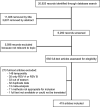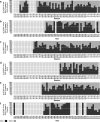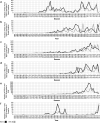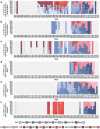Global distribution of respiratory syncytial virus A and B infections: a systematic review
- PMID: 35156555
- PMCID: PMC9518599
- DOI: 10.1080/20477724.2022.2038053
Global distribution of respiratory syncytial virus A and B infections: a systematic review
Abstract
Respiratory syncytial virus (RSV) is the main cause of severe respiratory infections in young children. The need for global epidemiologic data regarding RSV has been increasingly recognized. RSV A infections are reported more frequently than RSV B. Nonetheless, the temporal distribution of infections caused by both RSV groups has not been investigated globally. A systematic review was carried out regarding published studies on RSV A and B epidemiology, as well as RSV G gene ectodomain sequence data available at GenBank. A total of 76,668 [45,990 (60%) RSV A and 30,678 (40%) RSV B] positive samples from 83 countries were identified and included in the analysis. Genotype assignment was obtained in 5,340 RSV A and 2,518 RSV B sequences. Two patterns of RSV circulation were observed: continuous seasons with RSV A predominance and alternate predominance of RSV A and B. These patterns were observed in all regions, but the predominant RSV group seldom coincided in all continents during a given year or season. The most frequently identified RSV A genotype was NA1 (including ON1 viruses) (76.30%), and the most frequently identified RSV B genotype was BA (70.65%). Multiple genotypes circulated simultaneously throughout the evolutionary history of RSV, but genotype diversity decreased after the year 2000. The classification of RSV group and genotype is important for the development of vaccines, as well as to understand viral dynamics. This study displays the global and continental RSV circulation patterns from the first report of human RSV infection until the end of 2020.
Keywords: Respiratory syncytial virus; epidemiology; genotype; molecular epidemiology; respiratory viruses.
Conflict of interest statement
DEN has participated as a member of the speakers’ bureau of AbbVie and speakers’ bureau and advisory board for Sanofi Pasteur. All other authors declare that there are no competing interests regarding the publication of this manuscript.
Figures








References
-
- World Health Organization . Respiratory Syncytial Virus (RSV) disease. [Internet]. [cited 2021 Nov 16]. Available from: https://www.who.int/teams/health-product-policy-and-standards/standards-...
-
- Tseng HF, Sy LS, Ackerson B, et al. Severe morbidity and short- and mid- to long-term mortality in older adults hospitalized with respiratory syncytial virus infection. J Infect Dis. 2020. Sep 14;222(8):1298–1310. - PubMed
Publication types
MeSH terms
LinkOut - more resources
Full Text Sources
Other Literature Sources
Medical
